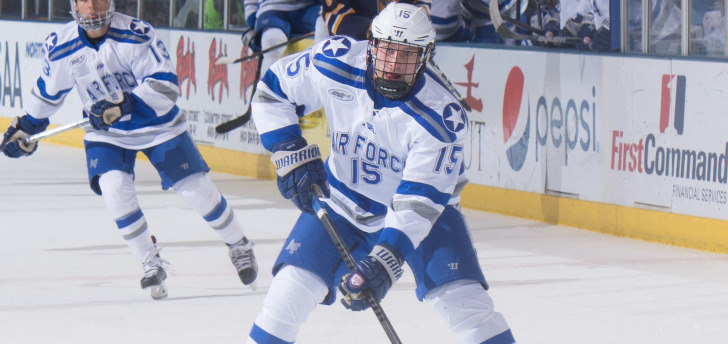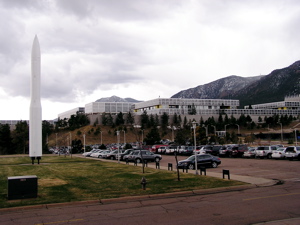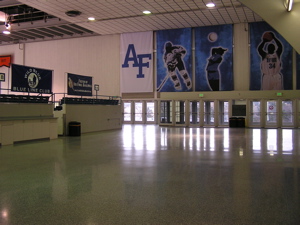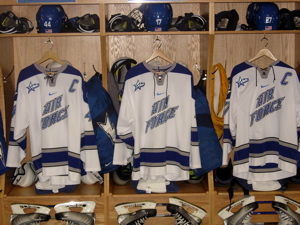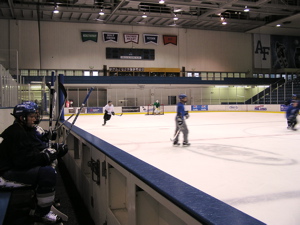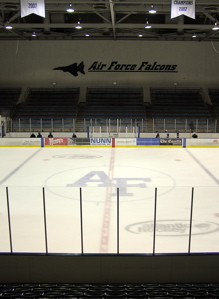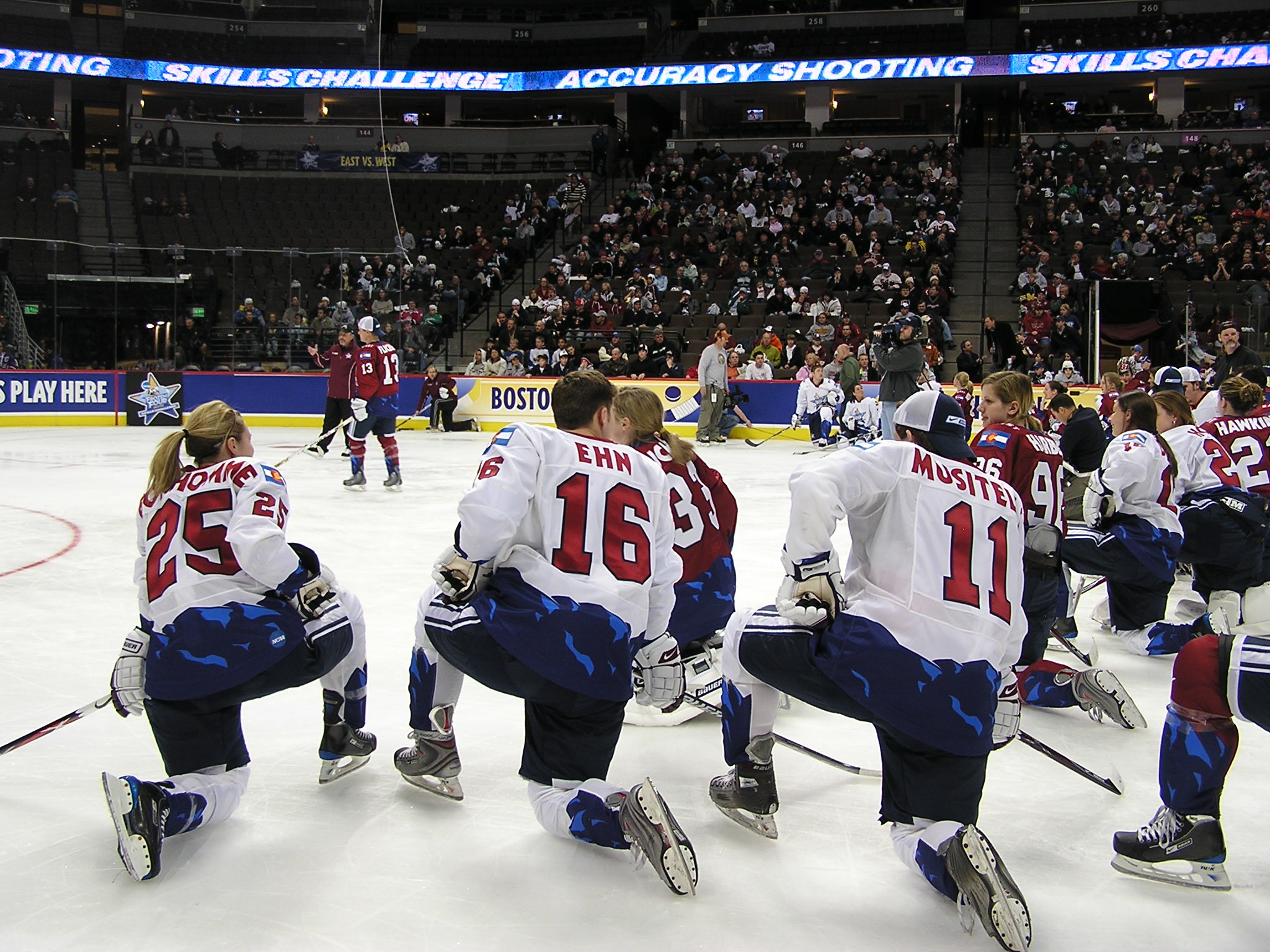|
||||||||||||||||||||||||||||||||||||||||||
|
||||||||||||||||||||||||||||||||||||||||||
Story ArchiveCoach SerratoreCoach Serratore is Air Force Hockey. Air force offered him the position over a dozen years ago while he was coaching professional hockey. "I didn't see a great future in pro hockey for me, I wasn't a former professional player; that really wasn't my fraternity. Everything I had done prior in my coaching development was to become a college coach. I think you're either a college coach or you're a pro coach and I'm a college coach. I just fit better in this environment. It was a great experience being able to coach professionally. It gave me some great insight, but I wanted to get back in the college coaching game."
So is Air Force. Coach Serratore has brought his enthusiasm and tireless work ethic to the Academy and his efforts have paid off in countless ways. Air Force is now considered a serious national contender, and the program has earned admiration and respect throughout the college hockey world, in the State of Colorado, and in the city of Colorado Springs where the Academy is located. Technically, the campus is located in USAF Academy, CO, which sits just north of Colorado Springs nestled at the base of the mountains. If you want to visit, drive to Colorado Springs, you'll find it. Cadet Rink
Actually, Coach Serratore believes visiting teams find the rink quite hospitable. "Our rink is a pretty family friendly rink, it's not a rowdy place. When we get a good crowd in here it's festive; I don't want to say it's a difficult place to play, I wish it was more difficult to play in for visiting teams. I think the most difficult facet of coming here and playing against us is playing at 7000 feet." All the Colorado schools seem to enjoy that advantage. (Check out the "Tunnel" picture in University of Denver section). "We have a nice building and it's a good environment; it's a good atmosphere. I guess you would have to ask opposing teams if they feel it is a tough place to play."
Because Air Force is a military service academy, the fan support comes more from the community than the Cadets. "We get more of the Air Force hockey service community here, people who have families that have an attachment with the military. And then we have townspeople that are Air Force fans. We don't get a ton of students, and I think one of the reasons is you're at the Academy here. We play our games on Friday and Saturday nights and the Academy kids like to get out of here on Fridays and Saturdays and go skiing or whatever; they're here all week and obviously it's a pretty challenging program. So we don't always have the student involvement we would like. Basketball sometimes gets more student involvement because they play a number of their games on weekdays." By the way, if you are planning on attending a game at Cadet rink, you need to drive through a guardhouse and provide photo I.D. It's not a big deal, but this was the only rink I visited where they asked me to open the trunk when I stopped at the checkpoint. Other than that it was just like visiting any rink, and the truth is, everyone I met at the Academy was very welcoming and very friendly. It's an impressive place to visit. Building a Legacy
He went on to credit his players for the team's most recent successes. "You're talking about a school that a lot of people didn't even know was Division One until a few years ago. This group of kids has really put the program on the map. Before Eric and our past two championships, I would have said (a memorable moment was) beating Denver, the program I was fired from, beating them when they were ranked third or fourth in the country this year. I mean that was huge, but it doesn't compare with the two championships, playing in the NCAA tournament, or Eric being honored as an All-American and Hobey hat trick finalist." Playing for Air Force
From the hockey perspective Coach Serratore and his staff know exactly the type of player they are looking for. "The biggest thing we look for is kids that can skate and kids that can get after it; if they can skate and get after it we're interested. I'm a big believer especially with the new rule changes that if you can skate you can defend, and our ability to skate over the last few years has enabled us to defend effectively. We led the nation three years in a row in fewest shots against. We virtually take peoples rush offense away with our ability to skate and defend."
"The biggest thing we look for is kids that can skate and kids that can get after it; if they can skate and get after it we're interested." Advice to ProspectsFor all of you future Air Force prospects out there, Coach Serratore has some advice. "First of all just continue to play. Ultimately you need to get to the Junior "A" level, in either the USHL or North American league, the Eastern Junior League or one of the tier two leagues in Canada. You need to be strong in your academics, you need to have good character, and you need to be a good citizen. If you advance to the Junior "A" level, we're going to watch you play. We don't care if you get there after high school, but ultimately you need to get to the Junior "A" level. If you can't play at the Junior "A" level you're not going to be able to play at our level. On the other hand, if you excel at that level, there's a good chance you can play for us." Often, players who find themselves playing Juniors in their 20's won't get a look from many schools. Air Force has taken a different approach. "We've found success here recruiting older junior players. That wasn't the case before I came here; there were very few junior "A" players who came to the Academy prior to my arrival. When I came here I wanted to get these junior A kids, the older kids. The Academy was a little reluctant. Our admissions liaison Jim Bowman had a background in hockey; his son Jordy was a college hockey player and was also an assistant coach here at the Air Force for many years, so Jim knew hockey. He pushed for us to be able to get these junior players in."
The formula has worked. "Now we have a history with them and since we've been recruiting junior players we've had way less attrition, and the kids are doing better academically. They just come here with more maturity about them, and they just handle the whole environment a lot better than young kids coming in right out of high school. But for the right kid who recognizes the great opportunity that the Air Force Academy provides, those are the kids we look for. Those are the kids that when we lay everything out on the table say, you know what, this is a pretty good deal. They're out there you just have to go find them." "For the right kid who recognizes the great opportunity that the Air Force Academy provides, those are the kids we look for. Those are the kids that when we lay everything out on the table say, you know what, this is a pretty good deal." For Coach Serratore, it's clear that the student athletes are the most important element of the Air Force hockey program. He closed our conversation with another anecdote about one of his other players, Brent Olsen. "In 2006 Brent Olsen was ruled academically ineligible at Christmas so he didn't participate in the NCAA tournament. He's a kid from northern Minnesota and as it turned out, we played Minnesota in the tournament. Brent never had a chance to play against the Gophers, which was a tough pill to swallow for a kid from Minnesota. He could have quit after his sophomore year without any further commitment to the Air Force, but he didn't quit. He decided to come back. He battled back, got on top of his academics, started on the fifth line this year, and worked his way up to where he was playing regularly. He ended up being tied with Jeff Hajner as one of our two leading scorers." His persistence paid off further. In 2007, Brent got his chance to play Minnesota. "This past Christmas, we played Minnesota in the Mariucci tournament. Brent scored both goals against the Gophers in a 2 - 2 tie, and he later went on to be the MVP of the Atlantic Hockey tournament. It's a great story of perseverance. I always say our Academy kids don't have any quit in them; Brent's a great example. The easy thing for him to do would have been to quit, to go somewhere else. He didn't. He stayed, he persevered; it was great to see. And that's a great life lesson, never give up, never quit." And as Coach Serratore is fond of saying "get after it." STORY ARCHIVE: From Third Lines to HeadlinesSometimes a kid just doesn't know when to quit. Sometimes a kid just keeps coming back for more despite personal setbacks, being cut from teams, and enduring people telling him in one way or another that he's just not good enough. Sometimes a kid proves them all wrong, rises above adversity and succeeds in ways that only he believes possible. And sometimes it's a good thing, a really good thing, because the world of college hockey wouldn't be the same without the players who simply don't know the meaning of the words can't, quit, or defeated. Air Force senior forward Eric Ehn never listened to the detractors, never got too discouraged, and never gave up on his dream of playing hockey at the highest levels. In 2007, the kid who 7 years earlier was cut from his midget team as a 16 year old was named one of the three best players in the nation. Eric Ehn was a Hobey Baker Hat trick finalist in his junior year at the Air Force Academy. Not bad for a former fourth liner. Air Force coach Frank Serratore tells Eric's story best. "When Eric was growing up, he never made any of the Triple "A" teams in the Detroit area. He always had to play at the lower level. He was in his last year of midgets, so he went and played Junior "B" or Junior "C" for some league I had never heard of before. Well, he caught the eye of a North American Junior team, they brought him in the next year and he went and played in the North American league. He caught the eye of a USHL team the next year; he went to Green Bay, and played in the USHL. We presented him with an opportunity to come play here at the Academy and he took it. He was a third line center at Green Bay in the USHL; a third line USHL center, but he came here."
"He came to a program that was going to provide him with the opportunity to be the kind of player that he wanted to be. I don't think he would have been a real good fourth line player, a role player type. He needed to be in a position where he had the puck on his stick. He was a first or second line center who needed to be called upon to win big draws and anchor a power play. And here's a kid that couldn't make his triple "A" team as a young player. "He came to a program that was going to provide him with the opportunity to be the kind of player that he wanted to be." But Eric just stayed with it; he loved the game and just kept playing at whatever level presented itself to him. And ultimately he became an All-American and a Hobey Hat trick finalist." Imagine that, the kid who some former coaches thought couldn't make the third lines, had evolved into a player who was making the headlines. Coach Serratore feels Eric's story needs to be told to all the kids who have ever tried out and been cut from a team. "Eric's story should be told to all these kids who are trying out for teams, because more kids are going to get cut from top teams than make tops teams. Kids need to read a story like this to say, 'you know if I don't make the top team when I'm a squirt or a peewee or a bantam or a midget, that's not the end of the road; that doesn't mean I'm done. I'm going to keep playing this game and whatever team I make I'll aspire to be the best player on that team, and to be the best teammate I can to the people on that team.' And eventually you can make it. I remember asking Eric, didn't you get mad? Didn't it anger you when you didn't make those teams? He kind of smiled and said; 'it angered my mom more than it angered me.' I just wanted to play."
© Copyright 2017 D1 Hockey | ||||||||||||||||||||||||||||||||||||||||||

